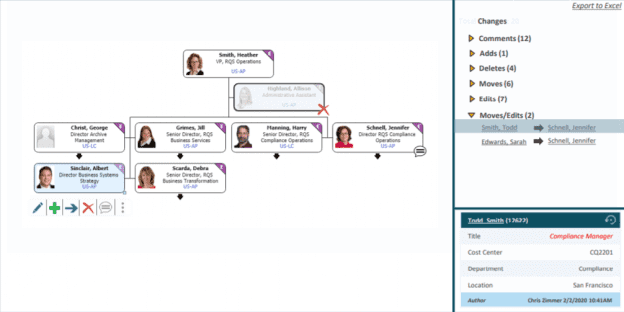October 6, 2020
4:48 PM
By OrgChart Team
With the end of the year fast approaching, and the seismic changes many businesses have faced, many management teams are looking at optimizing their workforce structures. With many offices still closed and more partners working remotely, these highly collaborative planning sessions may look a little different this year. Here are some tips for kicking off the planning process and collaborating virtually in an effective manner to achieve the best results for the team.
Gathering the stakeholders in one room may be a challenge this year but efforts should still be made to formally introduce the key players early in the process. In a report published last month, Making Virtual Teams Work: Redesigning Virtual Collaboration for the Future, authors recommended, “Whether a team is meeting for the first time or they know each other well, team-building, for a few minutes during each virtual meeting tends to deepen what teammates understand about each other, improve their abilities to interpret what each other say and do, and minimize misunderstandings.”
If an in-person meeting can’t be arranged or done safely, a video call could be the next best thing. Anything that reduces the virtuality of meetings will enhance the experience and productivity.
OfficeWork Software’s OrgChart Now is a cloud based org chart software offering a robust solution for workforce planning. Having a visual representation of the organization, pulling from real-time data sources across the organization, gives the planning process a solid foundation from the outset. Too often, without a real-time cloud-based solution, confusion is created by documents being sent to and from partners as attachments or complicated with different versions being badly communicated.
By hosting charts on the cloud, and making them accessible remotely, everyone can contribute and track changes without confusion.
One of the consequences of the digitalization of meetings is that more data is available. Not only does data have to be shared digitally in a way that’s easily accessible to others, but now the meetings can be recorded and participants’ interactions can be analyzed. The future of virtual team meetings is collecting data on the way participants interact with each other and using that to refine workflows and identify bottlenecks in the planning process. OrgChart Now already has robust activity tracking mechanisms in place to improve collaboration efforts. Edits to charts are time stamped and identified. Changes can be rolled back and comments can be consolidated for easy viewing.

OrgChart Now tracks and time stamps edits to the org chart
While workforce planning has to be a collaborative process, it may be the case that not every member of the team requires every data point to make their contribution. For example, a CEO may not want to share the executive compensation information with his or her managers. OrgChart Now makes it possible to hide row level data to those roles that don’t need access to that data. Choosing software that allows rule based security streamlines the process of validating the data for better decision making.
The leaders of the remote communication sessions should be aware of the limitations of the new meeting formats (i.e. Zoom as opposed to the conference table) and set expectations of the new way of working. For example, the use of emojis may have been seen as unprofessional in the past but may now be necessary to fill the gap of visual cues that were communicated face-to-face in the past.
OrgChart Now has comment boxes, clearly visible to all participants, to make free form annotations to communicate the reasoning behind suggestions or decisions that are being made during the collaboration process. It is up to the leader of the meetings to clearly lay out from the beginning the process for reviewing and making changes to the chart, all of which will be clearly tracked in the collaboration module of OrgChart Now.
Taking the necessary human and technical preparations before meetings can facilitate the important task of workforce planning for your organization. Collaboration has a strong psychological component in its success and removing layers of confusion from a remote meeting setting can only help speed up the process to a successful outcome. If you want to learn more about how the OrgChart Now collaboration module can help, schedule a demo with one of our experts today.
5 Rules For Virtual Collaboration Among Project Teams. July, 2014
Making Virtual Teams Work: Redesigning Virtual Collaboration for the Future. September, 2020
.
Tags: